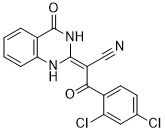Ciliobrevin A(HPI-4)
This product is for research use only, not for human use. We do not sell to patients.

For small sizes, please check our retail website as below: www.invivochem.com
| Size | Price | Stock |
|---|---|---|
| 500mg | $1350 | Check With Us |
| 1g | $2150 | Check With Us |
| 5g | $6400 | Check With Us |
Cat #: V18330 CAS #: 302803-72-1 Purity ≥ 98%
Description: Ciliobrevin A, formerly known as HPI-4 and Hedgehog Pathway Inhibitor 4, is a Hedgehog pathway inhibitor.
Top Publications Citing Invivochem Products
Publications Citing InvivoChem Products
Product Promise

- Physicochemical and Storage Information
- Protocol
- Related Biological Data
- Stock Solution Preparation
- Quality Control Documentation
| Molecular Weight (MW) | 358.18 |
|---|---|
| Molecular Formula | C17H9Cl2N3O2 |
| CAS No. | 302803-72-1 |
| Protocol | In Vitro | Ciliobrevin A also perturbs primary cilia formation in the Shh-LIGHT2FLAG-Gli1 cells and promotes accumulation of FLAG-Gli1 at the distal tip of this organelle. Ciliobrevin A significantly inhibits the proliferation of these neuronal progenitors, as measured by histone H3 phosphorylation (pH3) levels, and reduces cellular levels of cyclin D1 protein and Gli1, Gli2, and N-Myc transcripts in the CGNPs. Ciliobrevin A can block the proliferation of SmoM2-expressing CGNPs and should be equally potent against CGNPs lacking Su(fu) function, whereas the Smo inhibitor Cyclopamine is ineffective against either oncogenic lesion.Ciliobrevin A (HPI-4) also prevents an increase in the FLAG-Gli2 full-length/repressor ratio upon Shh stimulation, but HPI-2 and HPI-3 have no significant effect. Ciliobrevin A decreases FLAG-Gli1 stability in these cells, revealing another mechanism by which this small molecule can inhibit Hh target gene expression, while neither HPI-2 or HPI-3 has any significant effect on FLAG-Gli1 levels. Ciliobrevin A increases ciliary levels of FLAG-Gli2 in a manner disproportionate to their effects on total FLAG-Gli2 levels. In addition, Shh-EGFPFLAG-Gli2 cells cultured with Ciliobrevin A have truncated primary cilia, and this cellular organelle is absent in a significant fraction of Ciliobrevin A-treated cells. |
|---|
These protocols are for reference only. InvivoChem does not
independently validate these methods.
| Solvent volume to be added | Mass (the weight of a compound) | |||
|---|---|---|---|---|
| Mother liquor concentration | 1mg | 5mg | 10mg | 20mg |
| 1mM | 2.7919 mL | 13.9595 mL | 27.9189 mL | 55.8378 mL |
| 5mM | 0.5584 mL | 2.7919 mL | 5.5838 mL | 11.1676 mL |
| 10mM | 0.2792 mL | 1.3959 mL | 2.7919 mL | 5.5838 mL |
| 20mM | 0.1396 mL | 0.6980 mL | 1.3959 mL | 2.7919 mL |
The molarity calculator equation
Mass(g) = Concentration(mol/L) × Volume(L) × Molecular Weight(g/mol)
Mass
=
Concentration
×
Volume
×
Molecular Weight*
The dilution calculator equation
Concentration(start)
×
Volume(start)
=
Concentration(final)
×
Volume(final)
This equation is commonly abbreviated as: C1 V1 = C2 V2
Concentration(start)
C1
×
Volume(start)
V1
=
Concentration(final)
C2
×
Volume(final)
V2
Step One: Enter information below
Dosage mg/kg
Average weight of animals g
Dosing volume per animal µL
Number of animals
Step Two: Enter the in vivo formulation
%DMSO
+
%
+
%Tween 80
+
%ddH2O
Calculation Results:
Working concentration:
mg/ml;
Method for preparing DMSO master liquid:
mg
drug pre-dissolved in
µL
DMSO(Master liquid concentration
mg/mL)
,Please contact us first if the concentration exceeds the DMSO solubility of the batch of drug.
Method for preparing in vivo formulation:
Take
µL
DMSO master liquid, next add
µL
PEG300, mix and clarify, next add
µL
Tween 80,mix and clarify, next add
µL
ddH2O,mix and clarify.
Note:
- (1) Please be sure that the solution is clear before the addition of next solvent. Dissolution methods like vortex, ultrasound or warming and heat may be used to aid dissolving.
- (2) Be sure to add the solvent(s) in order.




































